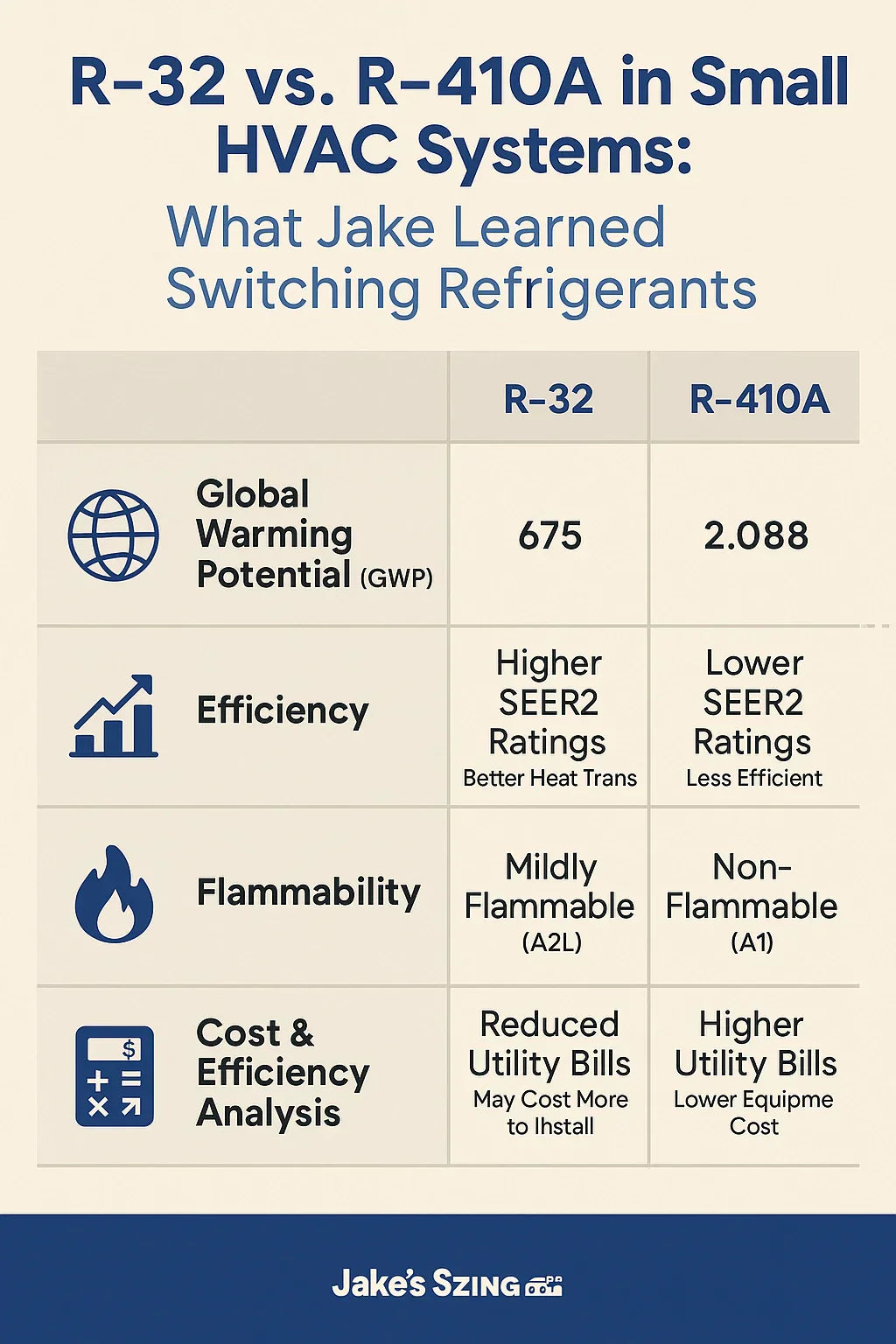🏠 Jake’s Backstory — Why I Switched
I’ll be honest: I wasn’t planning to swap out my old R-410A air conditioner and furnace combo until it started acting up.
But over the last two summers, I noticed two things:
-
My electric bills crept higher, even though my thermostat settings stayed the same.
-
On really hot afternoons, my 1.5-ton system ran almost non-stop — and still couldn’t get the temperature down.
A buddy in the HVAC trade mentioned R-32 refrigerant — “lower environmental impact, better heat transfer, future-proof.”
I dug into the details, and the more I read, the more I realized R-410A was on the way out in favor of R-32 and other low-GWP refrigerants.
So, when my R-410A system finally needed a major refrigerant top-off, I decided to replace it with an R-32 unit — a decision that’s been both educational and rewarding.
Best 1.5 Ton AC and Gas Furnaces
⚙ Technical Breakdown: R-32 vs. R-410A
📊 Global Warming Potential (GWP)
-
R-410A: ~2,088 GWP (over 2,000 times more warming potential than CO₂ over 100 years)
-
R-32: ~675 GWP — roughly 68% lower than R-410A
That’s a huge step toward meeting EPA AIM Act goals for phasing down high-GWP refrigerants (EPA.gov — AIM Act Overview).
💨 Pressure & Performance
Both R-410A and R-32 operate at similar pressures, so manufacturers can adapt system components without totally redesigning them.
But R-32 has better volumetric cooling capacity — meaning for the same volume of refrigerant, it transfers more heat.
For a small system like a 1.5-ton AC, that translates to:
-
Slightly smaller refrigerant charge
-
Marginally better energy efficiency (usually 5–8% in lab conditions)
🔥 Flammability Rating
-
R-410A: Non-flammable (A1 classification)
-
R-32: Mildly flammable (A2L classification)
In practice, that “mild flammability” is tightly managed:
-
Leak points are sealed with higher-grade fittings
-
Units have refrigerant sensors for safety
-
Techs get certified to handle A2L refrigerants
📎 ASHRAE R-32 Safety Guidelines
💧 Moisture Sensitivity
Both refrigerants require moisture control, but R-32 is a single-component refrigerant — it doesn’t suffer from composition shifts if a leak happens (unlike blends).
💰 Efficiency & Utility Bill Impact
When I upgraded to R-32, my installer explained that most of the bill savings come from:
-
Higher Seasonal Energy Efficiency Ratio (SEER2) ratings
-
Reduced compressor run times
-
Slightly less refrigerant volume needed
Jake’s Numbers
-
Old 1.5-Ton R-410A system: ~13 SEER (pre-SEER2 standard)
-
New 1.5-Ton R-32 system: 15.2 SEER2 (equivalent to ~16.5 SEER old rating)
-
Electric bill drop: ~8% in cooling season
Over 10 years, that’s hundreds of dollars saved — and better comfort because the system cycles efficiently.
🌍 Environmental & Regulatory Context
The EPA and international agreements like the Kigali Amendment are pushing for lower-GWP refrigerants worldwide.
Key points:
-
R-410A will be phased down in the U.S. by 2025 for most new residential systems
-
R-32 is already widely adopted in Japan, Australia, and Europe.
-
Global warming impact is significantly lower without sacrificing performance.
📎 Daikin — Global R-32 Adoption
🛠 Installation & Maintenance Differences
🔧 Training & Tools
R-32 requires:
-
A2L refrigerant handling certification (for pros)
-
Leak detectors rated for A2L refrigerants
-
Proper ventilation during service
♻ Retrofitting
You can’t just swap R-410A with R-32 in the same system — compressor, expansion device, and lubricants are different.
If you’re upgrading, it’s a full system replacement.
🧹 Maintenance Frequency
R-32’s single-component nature makes charging easier — no need to blend refrigerant proportions after a partial leak.
📊 Jake’s Real-World Before & After
| Factor | R-410A System | R-32 System |
|---|---|---|
| SEER/SEER2 | 13 SEER (~12.5 SEER2) | 15.2 SEER2 |
| GWP | 2,088 | 675 |
| Charge Weight | ~2.5 lbs | ~1.8 lbs |
| Cooling Performance on 95°F Day | Barely kept 78°F | Maintained 75°F with fewer cycles |
| Electric Bill (July) | $142 | $131 |
👂 Noise & Comfort
I noticed my R-32 system runs longer at low speed instead of blasting at high speed, which:
-
Reduces noise
-
Keeps humidity in check
-
Maintains steadier temperatures
⚠ Common Myths & Misconceptions About R-32
“It’s dangerous”
Fact: While R-32 is mildly flammable, system design + safety standards mitigate risks.
“It’s too new”
Fact: R-32 has been in use internationally since 2012 in millions of systems.
“No cost savings in small systems”
Fact: Even a 1.5-ton unit sees measurable efficiency gains, especially with variable-speed compressors.
✅ Jake’s Recommendation
If you:
-
Live in a moderate to hot climate
-
Need to replace a small R-410A system soon
-
Want lower bills and a future-proof refrigerant
→ R-32 is worth considering now rather than waiting.
If your system is still under 5 years old and in good shape, you can wait until replacement is necessary — but R-32 is where the market is going.
In the next topic we will know more about: How Much Does a 1.5-Ton R-32 AC/Gas Furnace Combo Cost in 2025?







